I am facing a problem regarding to add Null or nil value in NSArray. Actually I am adding Null value because my array count is not same. I am adding three array in Custom TableViewCell two array are from webservice and one array is from database. I am saving IndexPath in core data and then retrieving it.
As shown in Image I am saving indexPath in String and convert it in NSInteger from DidSelectAtIndexPath and show it in cellForRowAtIndexPath. My problem is, it's getting override because it is stored in string. So that I save it in coredataa and retrieve it but I get problem for mismatch count of array in cellforrowatindexpath. My code is like this
- (UITableViewCell *)tableView:(UITableView *)tableView cellForRowAtIndexPath:(NSIndexPath *)indexPath
{
static NSString *STI=@"STI";
AuditTableViewCell *cell = (AuditTableViewCell *)[tableView dequeueReusableHeaderFooterViewWithIdentifier:STI];
if (cell == nil)
{
NSArray *nib = [[NSBundle mainBundle] loadNibNamed:@"AuditTableViewCell" owner:self options:nil];
cell = [nib objectAtIndex:0];
cell.accessoryType=UITableViewCellAccessoryNone;
}
cell.audittitlelbl.text=[NSString stringWithFormat:@"%@",[idarray objectAtIndex:indexPath.row]];
cell.auditdesclbl.text=[NSString stringWithFormat:@"%@",[namearray objectAtIndex:indexPath.row]];
NSManagedObject *device2 = [devices objectAtIndex:indexPath.row];
NSMutableArray *Checkarray=[devices valueForKey:@"Key"]; // Hear in this array I am getting Index count problem
NSLog(@"Device =%@",device2);
NSLog(@"Check Array =%@",Checkarray);
if(indexPath.row == CurrentIndexPath)
{
cell.listlbl.text=GlobalString;
[cell setBackgroundColor:[UIColor greenColor]];
}
return cell;
}
- (void)tableView:(UITableView *)tableView didSelectRowAtIndexPath:(NSIndexPath *)indexPath
{
CurrentIndexPath=indexPath.row;
NSLog(@"Current Index Path =%ld",(long)CurrentIndexPath);
GlobalIndexPath = [[NSString stringWithFormat: @"%ld", (long)CurrentIndexPath] mutableCopy];
NSManagedObjectContext *context = [self managedObjectContext];
if (self.device) {
// Update existing device
[device setValue:GlobalStringChk forKey:@"Key1"];
[device setValue:GlobalIndexPath forKey:@"Key"];
} else {
// Create a new device
NSManagedObject *newDevice = [NSEntityDescription insertNewObjectForEntityForName:@"Device" inManagedObjectContext:context];
[newDevice setValue:GlobalStringChk forKey:@"Key1"];
[newDevice setValue:GlobalIndexPath forKey:@"Key"];
}
NSError *error = nil;
// Save the object to persistent store
if (![context save:&error]) {
NSLog(@"Can't Save! %@ %@", error, [error localizedDescription]);
}
[Audittable reloadData];
NSManagedObjectContext *managedObjectContext = [self managedObjectContext];
NSFetchRequest *fetchRequest = [[NSFetchRequest alloc] initWithEntityName:@"Device"];
self.devices = [[managedObjectContext executeFetchRequest:fetchRequest error:nil] mutableCopy];
}
This is my code hear I am saving indexpath in coredata and retrieving it in array. I have a problem for count of array in cellforrowatindexpath. How can I add Null or nil value in array so that it count get same. My Array is a dynamic array.The main problem is that I need to change the colour of cell if user click on it.when I store the value in NSInteger and convert it into indexpath I can change the colour But only for one cell at a time.When I click on other cell integer value get override. So for that I save it to core data and retrive but when I fetch core data array in cellforrowatindexpath it crash because of different count .Thanks in Advance!
